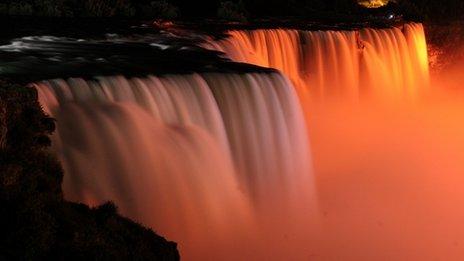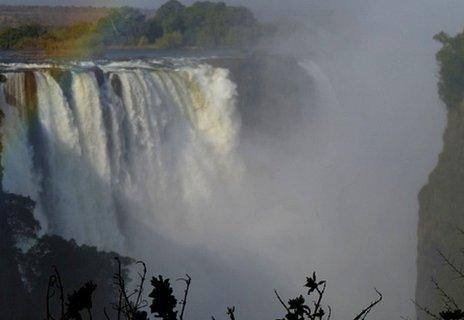Harrabin's Notes: Pride in a Falls
- Published
In his regular column, BBC environment analyst Roger Harrabin looks at the differences in the way the US and Zimbabwe protect similar parts of their natural heritage.
PRIDE IN A FALLS

Is the US providing enough protection for this natural wonder?
Internet promises of unforgettable hotels are often worthless, so my expectations of the hotel I'd booked at Niagara Falls were modest indeed.
The online blurb described a luxury room with spectacular Falls view from the Canadian side, but my mind's eye pictured a distant fingernail of white water in the corner of the window.
I was wrong. The wall-to-wall glazing of our sixth floor room presented a full-frontal frothing panorama, from the vast steaming bowl of the Horseshoe Falls on the right and stretching way over to the left towards the Bridal Veil falls on the US bank.
It is by a long way the most majestic hotel view I've experienced.
But surveying the natural wonder from such a towering vantage point left me uneasy, because our hotel so obviously dominated the Falls view from the other side of the falls.
And I really hated some of the human additions on the opposite bank - the ridiculous pink and green rivers of light smearing the US side of the falls courtesy of the Niagara Falls Illumination Board; the offensive skyscraper with stripes of blue-pink lights screaming up and down its ugly frontage, competing for attention with the Falls itself.
My focus was sharpened because by wonderful coincidence I also recently visited the magnificently unspoiled Victoria Falls.
It's the most magical place. From a quiet town on the Zimbabwe side or the Zambian bank you take a long walk to the cascades hidden from casual view in a rainforest reserve nourished by spray from the river.
Winding through the trees you happen upon viewpoint after exhilarating viewpoint, discovering bit by bit the majesty of Mosi-oa-Tunya - the Smoke that Thunders. You are witnessing a natural wonder from within Nature itself.

The cascades of Victoria Falls are hidden from casual view by a rainforest
That doesn't mean Vic Falls is free from human structures - in fact one of the most memorable perspectives of the Falls is from the historic rail bridge spanning the roaring Zambesi.
Built in 1905, it's a landmark in Edwardian engineering, etching a black lattice over the distant white cascade and viewed with affection by almost everyone who sees it.
Unlike my Niagara hotel, the bridge is a graceful structure which actually enhances the view. You can imagine a latter-day Livingstone introducing a Stanley to the delights of silver service tea and crumpets whilst suspended over the gorge.
Another factor is scale: from the Falls, that bridge is virtually the only structure in sight, apart from the elegant Victoria Falls Hotel, dubbed the Grand Old Lady of the Falls and standing a respectful distance from the water.
The falls at Niagara, on the other hand, are surrounded by buildings jostling to make money from the view - the closer the better. It means wealthy North America receives far times more from its natural wonder than impoverished Zimbabwe.
It doesn't bear to dwell on this too far, as Niagara's income derives largely from its accessibility to so many millions of rich Americans - very different from relatively remote Vic Falls. And it's also clear that the commodification of Niagara began when rules over nature protection were much less strict.
But does Niagara really need to look like Las Vegas on the water? Imagine the global outcry if the Zimbabweans planned skyscraper hotels looming over their natural wonder.
This seems an unlikely prospect, as Vic Falls has been protected since the colonial government imposed the Victoria Falls Reserve Preservation Ordinance in 1934. It is now a national park and a UNESCO World Heritage Site.
Niagara on the other hand does not have world heritage status. The US has sought UNESCO status for Cahokia Mounds State Historic Site in Missouri; the Carlsbad Caverns in New Mexico; and Monticello, Thomas Jefferson's home in Virginia, among surprisingly few others. But it has not sought listing for Niagara - perhaps because this would invite international oversight to this most commercialised of natural wonders.
It is to the shame of the US that impoverished Zimbabwe, an international pariah to many, is willing to protect its portion of the world's natural heritage more lovingly than a nation which can afford such protection so much more.
Roger is currently on a Knight Wallace media fellowship at the University of Michigan.
- Published11 January 2011
- Published13 December 2010
- Published9 December 2010